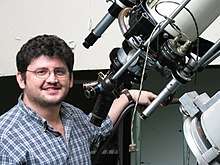Roberto Abraham
Roberto Abraham, FRSC (born 12 Apr 1965, Manila, Philippines) is a Canadian astronomer and is Professor of Astronomy at the University of Toronto and a Fellow of the Royal Society of Canada.
Roberto Abraham | |
|---|---|
 | |
| Born | 12 April 1965 |
| Alma mater | University of British Columbia |
| Known for | Observational cosmology, galaxy evolution, first galaxies |
| Scientific career | |
| Fields | Astronomy, astrophysics, cosmology |
| Institutions | University of Toronto |
| Thesis | Imaging of BL Lac Objects (1992) |
| Doctoral advisor | Ian M. McHardy and Roger Davies |
| Website | www |
Education
Abraham received a Bachelor of Science from the University of British Columbia in 1987 and a PhD from Oxford University in 1992, working under the supervision of Ian M. McHardy and Roger Davies.[1]
He did post-doctoral work at the Dominion Astrophysical Observatory, the Institute of Astronomy, Cambridge and the Royal Greenwich Observatory.[1]
Career
Abraham's career has been notable for his contributions via non-parametric statistics to galaxy morphological classification, especially at high-redshift and early work on the Hubble Deep Field.[2] He was one of the leaders of the "Gemini Deep Deep Survey"[3] which led to several notable results on early galaxies including the evolution of elliptical galaxies and why a lot of them appear so remarkably old.[4]
He is currently a co-principal-investigator on the Dragonfly Telephoto Array telescope, which images ultra-low surface brightness galaxies at visible wavelengths of light.[5]
Abraham was the President of the Canadian Astronomical Society from 2016 to 2018.[6] He currently serves the astronomical community by participating on the James Webb Space Telescope Advisory Committee[7] and is Honorary President of the Toronto Centre of the Royal Astronomical Society of Canada.[8]
Awards and recognition
- 2005 - University of Toronto Faculty of Arts & Science Outstanding Teaching Award [9]
- 2011 - Canadian Astronomical Society P.G. Martin [10]
- 2015 - Fellow of the Royal Society of Canada [11] [12]
- 2017 - Canada Council Killam Research Fellowship [13]
References
- Abraham's departmental biography page
- Galaxy morphology to I=25 mag in the Hubble Deep Field, 1996, MNRAS, 279 L47
- Gemini Observatory - the Gemini Deep Deep Survey
- Casey Kazan; The early universe puzzle, The Daily Galaxy (June 15th 2011).
- "Dragonfly - Dunlap Institute". Dunlap Institute. Retrieved 2018-10-15.
- "Past Officers and Directors of the Society - CASCA". casca.ca. Retrieved 2018-10-15.
- "JWST Advisory Committee (JSTAC)". jwst.stsci.edu. Retrieved 2018-10-15.
- "RASC Toronto Centre Organization | RASC Toronto". rascto.ca. Retrieved 2018-10-15.
- "OTA: Recipients — Site". www.artsci.utoronto.ca. Retrieved 2018-10-15.
- "Martin Award - CASCA". casca.ca. Retrieved 2018-10-15.
- "U of T's Abraham becomes new Fellow of the Royal Society of Canada - Dunlap Institute". Dunlap Institute. Retrieved 2018-10-15.
- "FELLOWS DIRECTORY | The Royal Society of Canada". rsc-src.ca. Retrieved 2019-11-05.
- "Roberto Abraham - using the Dragonfly Array telescope for new discoveries | Killam Laureates". killamlaureates.ca. Retrieved 2018-10-15.